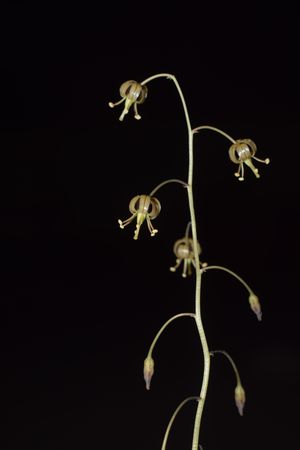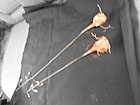Note: This is a project under development. The articles on this wiki are just being initiated and broadly incomplete. You can Help creating new pages.
Difference between revisions of "Drimia indica - Kolakanda"
(→References) |
|||
| (4 intermediate revisions by 2 users not shown) | |||
| Line 3: | Line 3: | ||
==Uses== | ==Uses== | ||
{{Uses|Skin diseases}}, {{Uses|Cold}}, {{Uses|Cough}}, {{Uses|Difficulty in micturition}}, {{Uses|Cardiac problems}}, {{Uses|Intestinal worms}} <ref name="Uses"/> | {{Uses|Skin diseases}}, {{Uses|Cold}}, {{Uses|Cough}}, {{Uses|Difficulty in micturition}}, {{Uses|Cardiac problems}}, {{Uses|Intestinal worms}} <ref name="Uses"/> | ||
| + | |||
| + | ===Food=== | ||
| + | Kolakanda can be used in Food. Tubers are eaten raw or cooked as vegetable. Tender leaves are cooked as vegetable<ref name="Forest foods of Western Ghat"/>. | ||
==Parts Used== | ==Parts Used== | ||
| Line 10: | Line 13: | ||
==Common names== | ==Common names== | ||
| − | {{Common names|kn=Kaadu bellulli | + | {{Common names|kn=ಬಿಳಿ ಈರುಳ್ಳಿ Bili eerulli, ಕಾಡು ಬೆಳ್ಳುಳ್ಳಿ Kaadu bellulli|ml= Kaattulli, Kaanthenga|sa=Asmantaka, Kolakanda|ta= Ciruvenkayam, Kaattu vengayam|te=Adavithellagadda, Kaazagadda, Nakka-vulli-gadda|hi=Ban piaz, Jangli piaz, Janglikanda|en= Indian squill, Sea onion, White squill}} |
<ref name="Common names"/> | <ref name="Common names"/> | ||
| Line 28: | Line 31: | ||
Vata | Vata | ||
===Prabhava=== | ===Prabhava=== | ||
| + | |||
| + | ===Nutritional components=== | ||
| + | Cleome viscosa Contains the Following nutritional components like - Vitamin-A, B and C; Cardiac glycosides; Flavonoids- Quercetin, Kaempferol, Sinistrinn; Calcium oxalate; Glycosides - scillaren-A and scillaren-B; Calcium, Copper, Iron, Magnesium, Manganese, Potassium, Phosphorus, Sulphur, Zinc<ref name="Forest foods of Western Ghat"/>. | ||
==Habit== | ==Habit== | ||
| Line 51: | Line 57: | ||
{{Propagation|Seeds}}, {{Propagation|Bulbs}}. | {{Propagation|Seeds}}, {{Propagation|Bulbs}}. | ||
| − | == | + | ==Cultivation Details== |
| − | + | Drimia indica is available through February-May<ref name="Forest foods of Western Ghat"/>. | |
===Season to grow=== | ===Season to grow=== | ||
| Line 70: | Line 76: | ||
==References== | ==References== | ||
| − | |||
<references> | <references> | ||
<ref name="Uses">[https://easyayurveda.com/2017/08/13/indian-squill-urginea-indica/ Uses]</ref> | <ref name="Uses">[https://easyayurveda.com/2017/08/13/indian-squill-urginea-indica/ Uses]</ref> | ||
| − | |||
<ref name="Leaf">[http://keralaplants.in/ BOTANIC DESCRIPTION]</ref> | <ref name="Leaf">[http://keralaplants.in/ BOTANIC DESCRIPTION]</ref> | ||
| − | <ref name="Common names">[ | + | <ref name="Common names">[https://sites.google.com/site/indiannamesofplants/via-species/d/drimia-indica Vernacular names]</ref> |
| + | <ref name="Forest foods of Western Ghat">"Forest food for Northern region of Western Ghats" by Dr. Mandar N. Datar and Dr. Anuradha S. Upadhye, Page No.71, Published by Maharashtra Association for the Cultivation of Science (MACS) Agharkar Research Institute, Gopal Ganesh Agarkar Road, Pune</ref> | ||
</references> | </references> | ||
==External Links== | ==External Links== | ||
| − | * http://tropical.theferns.info/viewtropical.php?id=Drimia+indica | + | * [http://tropical.theferns.info/viewtropical.php?id=Drimia+indica Drimia indica on theferns.info] |
| − | * https://www.sciencedirect.com/science/article/pii/S0254627217300365 | + | * [https://www.sciencedirect.com/science/article/pii/S0254627217300365 Drimia indica on sciencedirect.com] |
Latest revision as of 12:51, 27 October 2021
Kolakanda is a bulbous perennial plant with delicate maroonish pendant flowers that bloom from leafless bulbs during the summer. The strap shaped leaves appear in the rainy season. The bulb is eaten by locals. Kolakanda is found throughout India in stony or gravelly substrate.
Contents
- 1 Uses
- 2 Parts Used
- 3 Chemical Composition
- 4 Common names
- 5 Properties
- 6 Habit
- 7 Identification
- 8 List of Ayurvedic medicine in which the herb is used
- 9 Where to get the saplings
- 10 Mode of Propagation
- 11 Cultivation Details
- 12 Commonly seen growing in areas
- 13 Photo Gallery
- 14 References
- 15 External Links
Uses
Skin diseases, Cold, Cough, Difficulty in micturition, Cardiac problems, Intestinal worms [1]
Food
Kolakanda can be used in Food. Tubers are eaten raw or cooked as vegetable. Tender leaves are cooked as vegetable[2].
Parts Used
Chemical Composition
Common names
| Language | Common name |
|---|---|
| Kannada | ಬಿಳಿ ಈರುಳ್ಳಿ Bili eerulli, ಕಾಡು ಬೆಳ್ಳುಳ್ಳಿ Kaadu bellulli |
| Hindi | Ban piaz, Jangli piaz, Janglikanda |
| Malayalam | Kaattulli, Kaanthenga |
| Tamil | Ciruvenkayam, Kaattu vengayam |
| Telugu | Adavithellagadda, Kaazagadda, Nakka-vulli-gadda |
| Marathi | NA |
| Gujarathi | NA |
| Punjabi | NA |
| Kashmiri | NA |
| Sanskrit | Asmantaka, Kolakanda |
| English | Indian squill, Sea onion, White squill |
Properties
Reference: Dravya - Substance, Rasa - Taste, Guna - Qualities, Veerya - Potency, Vipaka - Post-digesion effect, Karma - Pharmacological activity, Prabhava - Therepeutics.
Dravya
Rasa
Tikta (Bitter), Katu (Pungent)
Guna
Laghu (Light), , Teekshna (Strong)
Veerya
Ushna (Hot)
Vipaka
Karma
Vata
Prabhava
Nutritional components
Cleome viscosa Contains the Following nutritional components like - Vitamin-A, B and C; Cardiac glycosides; Flavonoids- Quercetin, Kaempferol, Sinistrinn; Calcium oxalate; Glycosides - scillaren-A and scillaren-B; Calcium, Copper, Iron, Magnesium, Manganese, Potassium, Phosphorus, Sulphur, Zinc[2].
Habit
Identification
Leaf
| Kind | Shape | Feature |
|---|---|---|
| Simple | Rosette | Bulbous, scapigerous herbs; bulbs tunicated, 3.5-6 x 2.5-6.5 cm, globose-conical. Leaves radical with sheathing base, 13-25 x 0.6-2.5 cm, linear, lanceolate or lorate. |
Flower
| Type | Size | Color and composition | Stamen | More information |
|---|---|---|---|---|
| Bisexual | Scape | Purplish brown | 6 | Scapes 17-45 cm tall, erect, purpish brown, 4-15-flowered. |
Fruit
| Type | Size | Mass | Appearance | Seeds | More information |
|---|---|---|---|---|---|
| A capsule | 10-20 x 5-10 mm | Brownish yellow | Seeds 4-10 in each cell, 4-7 x 3-4 mm, winged. | {{{6}}} |
Other features
List of Ayurvedic medicine in which the herb is used
Where to get the saplings
Mode of Propagation
Cultivation Details
Drimia indica is available through February-May[2].
Season to grow
Soil type
Propagation
Commonly seen growing in areas
Photo Gallery
References
- ↑ Uses
- ↑ 2.0 2.1 2.2 "Forest food for Northern region of Western Ghats" by Dr. Mandar N. Datar and Dr. Anuradha S. Upadhye, Page No.71, Published by Maharashtra Association for the Cultivation of Science (MACS) Agharkar Research Institute, Gopal Ganesh Agarkar Road, Pune
- ↑ Vernacular names
- ↑ BOTANIC DESCRIPTION
External Links
- Ayurvedic Herbs known to be helpful to treat Skin diseases
- Ayurvedic Herbs known to be helpful to treat Cold
- Ayurvedic Herbs known to be helpful to treat Cough
- Ayurvedic Herbs known to be helpful to treat Difficulty in micturition
- Ayurvedic Herbs known to be helpful to treat Cardiac problems
- Ayurvedic Herbs known to be helpful to treat Intestinal worms
- Herbs with Rhizome used in medicine
- Herbs with common name in Kannada
- Herbs with common name in Hindi
- Herbs with common name in Malayalam
- Herbs with common name in Tamil
- Herbs with common name in Telugu
- Herbs with common name in Sanskrit
- Herbs with common name in English
- Habit - Herb
- Index of Plants which can be propagated by Seeds
- Index of Plants which can be propagated by Bulbs
- Herbs that are commonly seen in the region of Tropical area
- Herbs
- Asparagaceae
- Ayurvedic herbs that don't have flower, fruit and leaf photos
- Ayurvedic herbs that don't have seed photos

